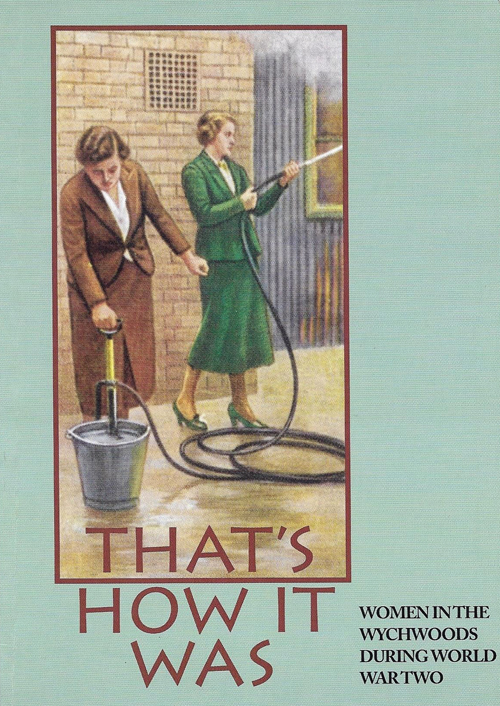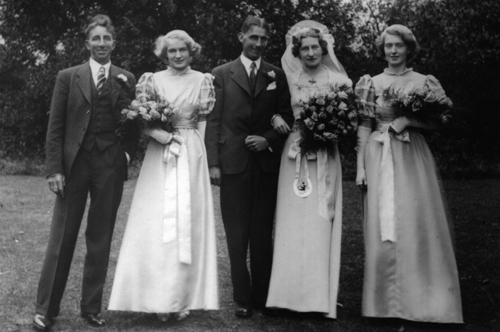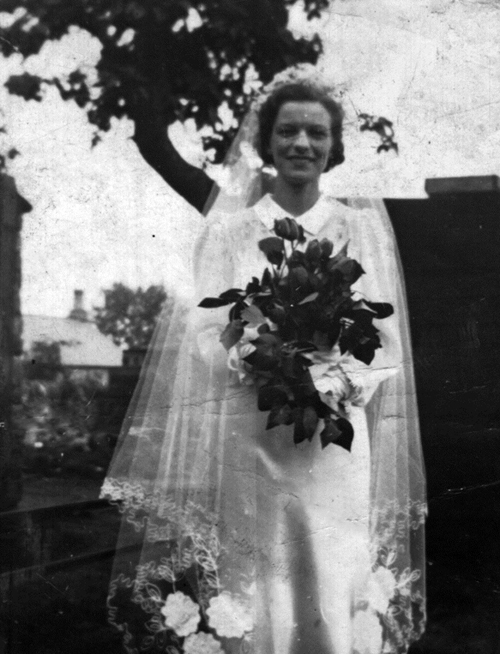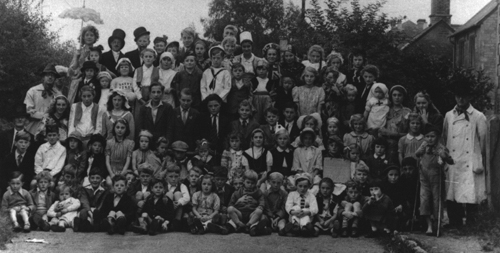“That’s How it Was” | Introduction | Wychwood Women : The Interviewees | Declaration of War | The Arrival of Evacuees| School Time | Preparing for War at Home | Soldiers and Airmen | For the Common Cause | Dr Scott and the Canteen | Domestic Life | We Were Lucky Out Here: Food Rationing | Work for Women Outside the Home | The Effects of War

… from the Wychwoods “That’s How It Was” Publication
Our interviewees showed amazingly little emotion when talking about the events of the war. Frightening incidents were described matter-of-factly with no great show of fear, anger or hatred. There was only one ‘terrified’. Expressions used of events were ‘worried’, ‘a little worried’, ‘frigid’, ‘terrible’. Daphne Edginton describes what happened to her the morning after war was declared. Her honest description of crying was one of two mentions of tears in the interview.
‘I got up very early in the morning – I was still at home, of course, at Churchill Heath, and I got the wireless on and the first thing I heard the Athenian ship was sunk in the Atlantic. I burst into tears. I don’t often burst into tears but I did that morning. It really brought it home to us what was happening. And one of our friends, a neighbouring farmer, had just been on it to America for a tour, an agricultural tour of America – the very ship. We couldn’t believe it’. Daphne Edginton
She also described the advent and prolonged stay of two of the many wartime guests at Churchill Heath. They were ‘terrified’ by war.
‘A daughter brought her mother up from Hythe, Kent because they were terrified. This mother was nearly 90, totally deaf, and the daughter put her in the car with a few bits of their prized belongings, silver and jewellery, and came to the White Hart in Chipping Norton.
We knew the proprietor of the White Hart there quite well and they landed there. They wanted to get out of the hotel into somebody’s house so we had them. My mother would have anybody! So, they had a bedroom and the dining room. We’d still got the breakfast room and the kitchen. And, believe it or not, in 1941 the daughter died of Hodgkins disease before the mother, so here we were left with the mother, this old lady, deaf as a post.’ Daphne Edginton
Joan Hall, whose father was a signalman at Bruern railway crossing and whose mother had died several years before the war, described the dark, lonely nights at the height of the bombing.
Presumably the war changed things for your father workwise? The number of trains would have increased.
‘Actually that was our biggest worry. At home, with my sister who was a year older than me and my other sister who was five years younger, of course my dad had to work nights and we were afraid. He was in the signal box and the stairs came up outside at Bruern and of course we were worried at home in case he got bombed being on the railway line and he was worried in case we did at home.’ Joan Hall
‘Father did get a little worried about German planes going over as he had one brother in Birmingham and another in Coventry and there were frequent raids there. Father went walking at night, watching the lights and the lights of fires in the sky.’ Betty Brown
What about the first siren or air raid warning?
‘Well, as I say, I was in Chipping Norton at the time. It must have been September or October 1939. I was living there at that time and the warning went and it was the first time ever and we all went down the lower floor and sat feeling absolutely frigid.’ Daphne Edginton
The bombing of Coventry was a consistent memory.
‘Yes, when that happened we wondered what on earth was happening by the number of planes that were coming over and we went in the car up to the Merrymouth up the road and there we could see these lights flashing and sparks flying and we found it was Coventry the next day. We didn’t think you could see it from a distance. Just shows how it shows up in the darkness and how high the sparks come up – the explosions. ‘ Daphne Edginton
‘I can remember when Coventry was bombed, that was a very bad night, yes. We were coming home with the Baptist minister’s wife – she used to run a club and I used to go there – and when we were coming home that particular night, you could see the red light on the horizon and the glow of the fire and that and you could hear the planes going droning over, the Germans, I can remember that very well.’ Mary Barnes
‘Yes, when Coventry was blitzed, the one big night they did it, we went up on, dozens of us, I don’t know how we come together, went up to the bridge up here and you could see Coventry being – you could see all the fires from Coventry in the sky. It really lit the sky up. It was terrible because by that time lots of soldiers had got up there and seen and a lot of them came from Coventry and it must have been awful for them. We always felt sorry for them that night because it was absolutely terrific.’ Joan Hall
As this project has been concerned with women in the Wychwoods during the Second World War, the menfolk and those serving in the armed forces have only been mentioned in passing, but were often, or perhaps always, in the women’s minds. On the declaration of war, many must have shared Vi Smith’s apprehension:
Was it a dramatic event?
‘Well of course I was naturally worried whether my husband would have to go, but as he was in food processing he was exempt. It was necessary for him to help to run the mill so fortunately he didn’t have to go. I mean when the Second World War started they said, ‘Oh, it won’t last many weeks’ and look at it.’ Vi Smith
Six years later, when peace in Europe was made on 8 May 1945, at least 200 men and women from Ascott, Milton and Lyneham, and Shipton had at some time been on Active Service.
Most of their names have been gathered from the records of the Comforts Fund and from the record in Ascott’s Tiddy Hall compiled by Eric Moss which recorded Dorothy Harrison as the only woman from Ascott on Active Service.
Most of the 200 survived the war having served in many parts of the world. Even so it must have been a worry for all those left behind in the Wychwoods, especially for the four families whose menfolk were posted as ‘Missing’, but later turned up as Prisoners of War.
But lives were lost as the War Memorials record, four from Ascott, five from Milton, Bruern and Lyneham and eight from Shipton. From these names, no child lost a father and only one woman lost her husband. All will be remembered.
During the war years local burials included those who had been on Active Service, evacuated persons, victims of road accidents and persons of all ages from two and half months to 94 years. With no known grave is May Muriel Clifford from Shipton who died on the Gloucester Castle on its way to South Africa.
Ken Masters of Ascott wrote home in 1944 from Italy on 15 September, ‘all bombs and gunfire out here. Oh to be home in Ascott‘. Two days later Ken was killed at Morchiano and lies buried in the Commonwealth War Graves Cemetery at Corriano Ridge, Italy.
Wally Barrett, Cyril Dangerfield, Ken Wright and Ken Masters were to die on Active Service. John Collett was killed in a farming accident. Les Barnes married Mary Bond, one of the evacuees to Milton.
Most of those who had been evacuated here officially or otherwise returned to the cities. Those who had served with the armed forces returned home more slowly. Some wartime relationships ended in tragedy but many flourished and it is right to end with the hopefulness of the victory celebrations and the immediate post-war weddings. Betty Brown remembered the VE day celebrations at RAF Little Rissington.
‘We heard in the morning. We had a dance band so we celebrated in the canteen. There were airmen there who went round cutting the ends off each other’s ties. Everyone went crazy’. Betty Brown
A year later she married Addy Brown whom she had met at Rissington.

‘We were married in Milton Church in 1946. I had a white wedding as someone had given me a book of clothing coupons so I was able to buy a white wedding dress. But, of course, everything was short. We had dockets for [utility] furniture and, as food was short, we only had 30 guests at the reception in the British Legion hall with sausage rolls and sandwiches and two bottles of sherry’. Betty Brown
Mary Barnes, evacuated here as an eleven year old from London three day before war had been declared ‘for a fortnight’s holiday’, decided to stay on when her mother returned to London. She had been saving for her marriage to Leslie Barnes. She had borrowed a wedding dress from her aunt.
Do you remember the Red Triangle hut at Shipton?
‘Yes, that’s where I had my wedding reception, there on 23 June. I had been working at the shop and, of course, everything was on ration and I’d been saving all these things up, jellies and that sort of thing. And it was such a hot day, I can remember, and all the jellies melted. It was corrugated iron’. Mary Barnes

Betty Scott has a particular memory of the end of the war.
‘When the troops came back and grocer’s chap came to take an order at the back door he enthusiastically held out his hand to be shaken and said ‘Its so nice to see old faces, Mrs Scott.’ It made me feel about 106′.

As we say farewell to the twentieth century, it is worth a moment to consider the essential value of the Wychwood women who gave so much in World War Two, as surely as their menfolk did. They are the unsung heroines of the Wychwoods.
“That’s How It Was” Menu
These pages are reproduced from the Society’s publication “That’s How It Was”, featuring women in the Wychwoods during World War Two. The texts and images were published in the year 2000, and deserve a place in our expanding online archive. Please bear in mind as you read our texts in these pages, that we reproduce them as published in the year of publication.
Select from:
“That’s How it Was” | Introduction | Wychwood Women : The Interviewees | Declaration of War | The Arrival of Evacuees| School Time | Preparing for War at Home | Soldiers and Airmen | For the Common Cause | Dr Scott and the Canteen | Domestic Life | We Were Lucky Out Here: Food Rationing | Work for Women Outside the Home | The Effects of War

